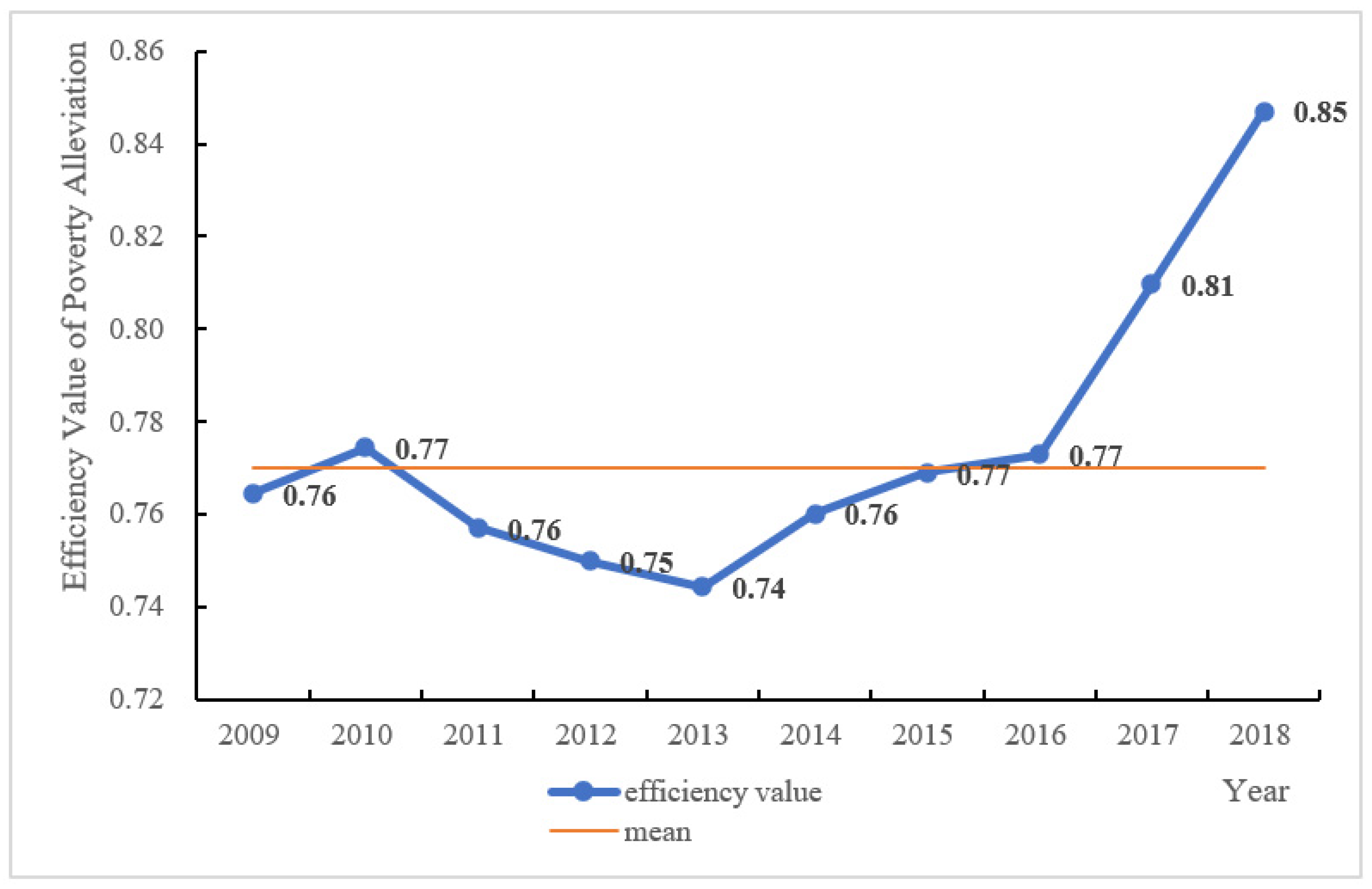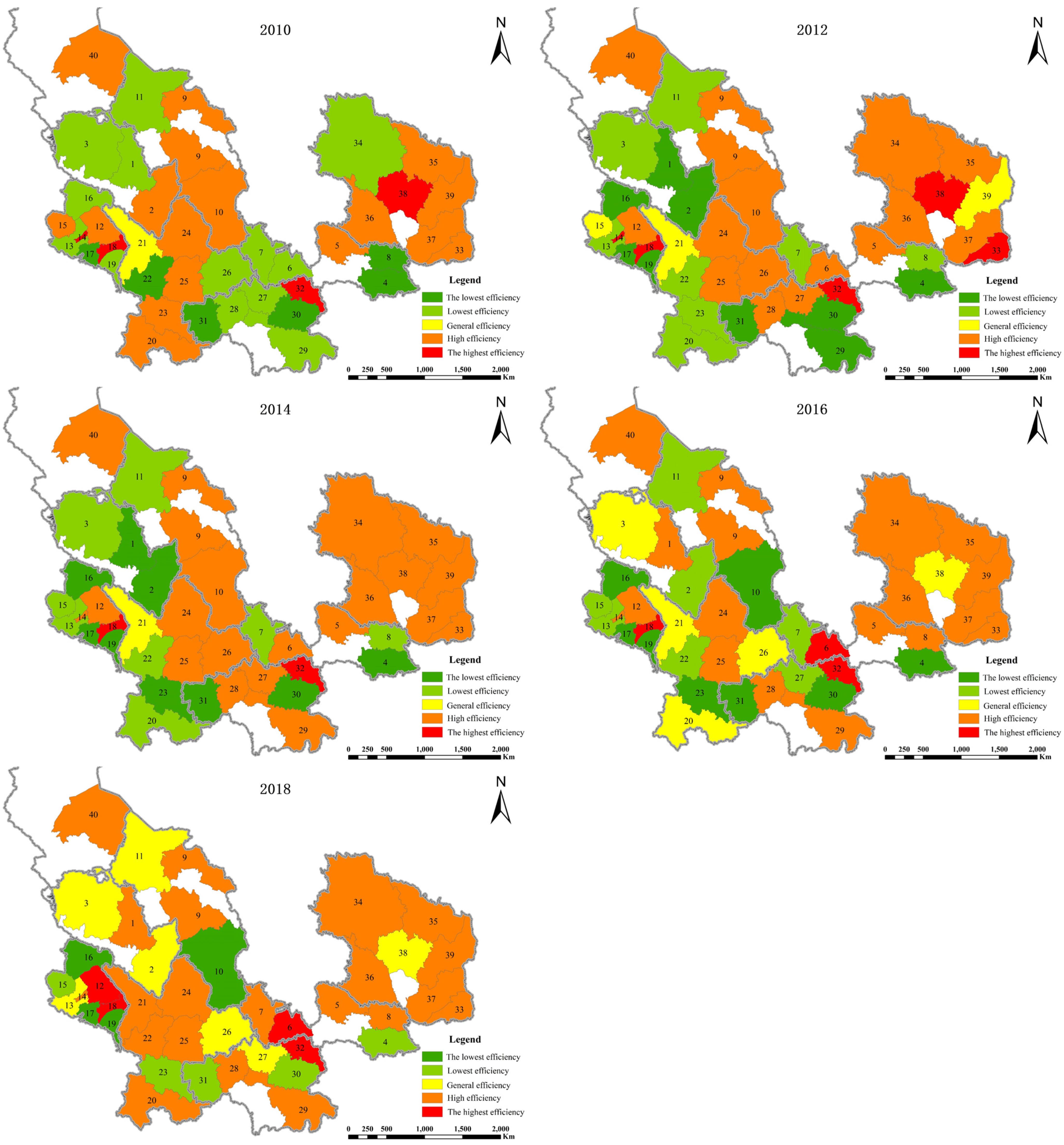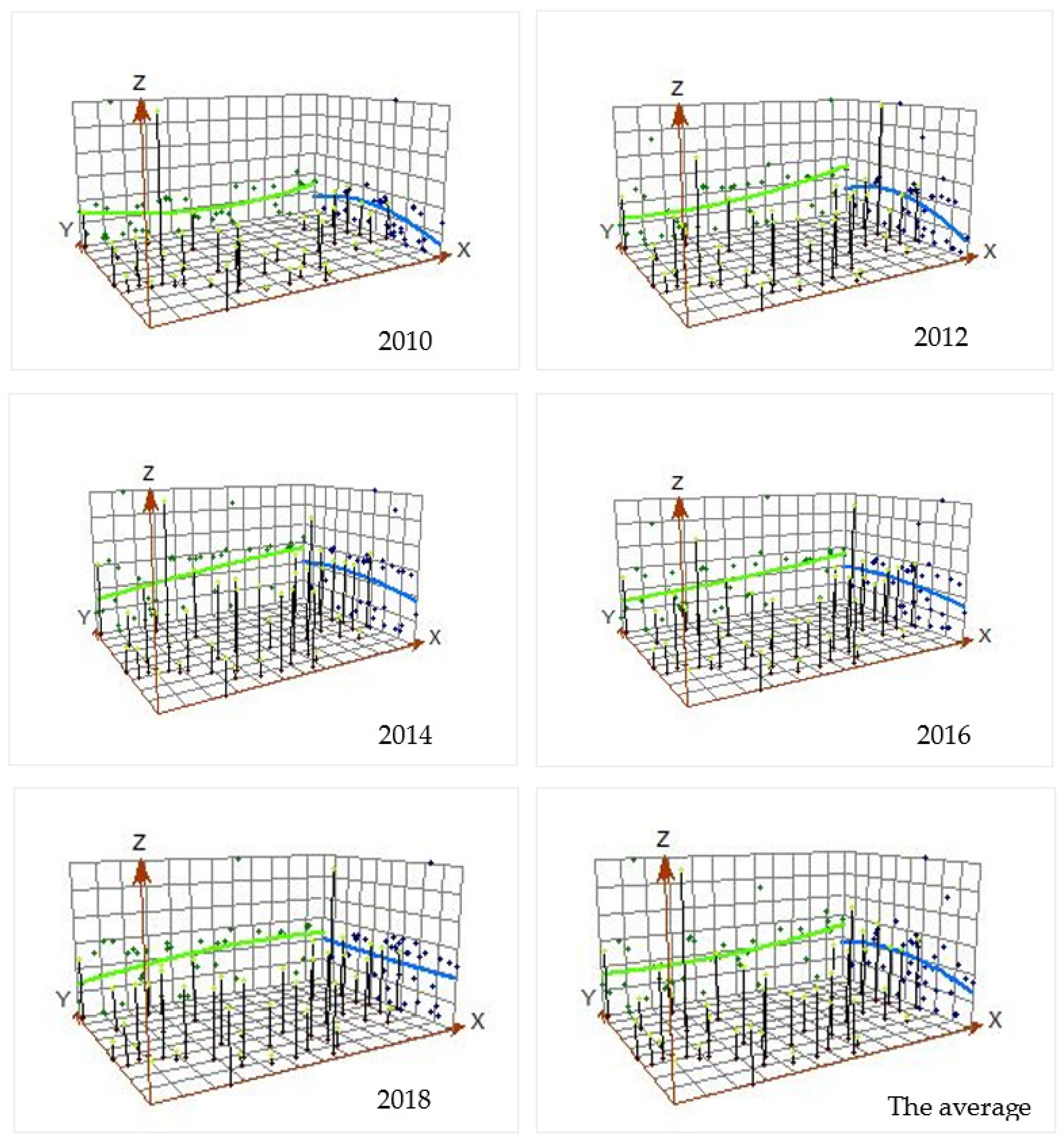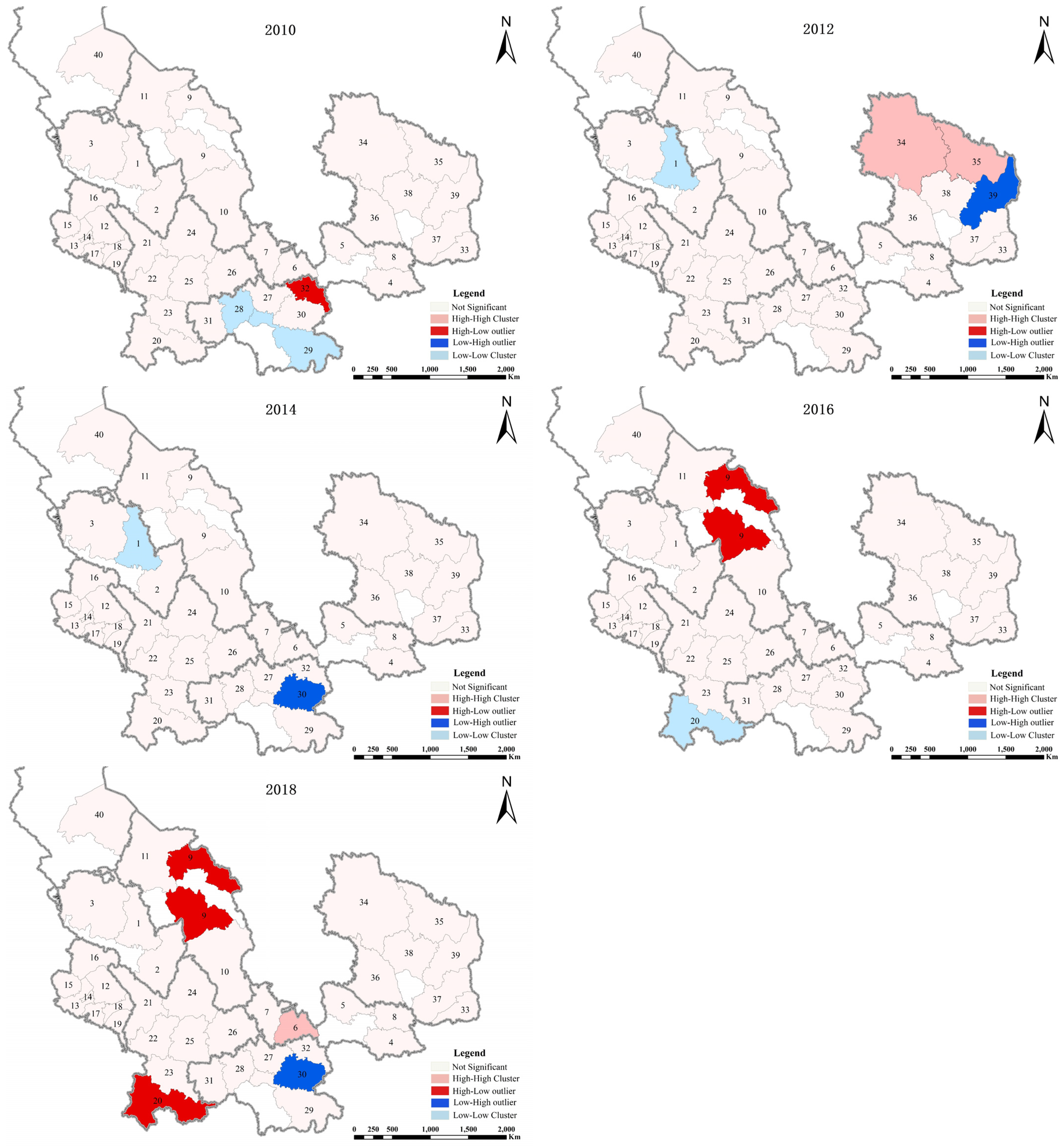The Measurement and Temporal and Spatial Evolution of Tourism Poverty Alleviation Efficiency in the Liupan Mountain Area of Gansu Province, China
Abstract
:1. Introduction
2. Research Area and Research Methods
2.1. Overview of the Study Area
2.2. Research Methods
2.2.1. Super-SBM Model
2.2.2. Coefficient of Variation
2.2.3. Malmquist Index
2.2.4. Spatial Trend Surface Analysis
2.2.5. Spatial Autocorrelation Analysis
- (1)
- Global spatial autocorrelation analysis
- (2)
- Local spatial autocorrelation analysis
2.3. Construction of Indicators System
2.4. Data Sources
3. Results and Analysis
3.1. Measurement of the Tourism Poverty Alleviation Efficiency
3.2. Time Series Evolution
3.2.1. The Difference in the Efficiency of Tourism Poverty Alleviation
3.2.2. MI and Its Dynamic Analysis
3.3. Evolution of Space Sequence
3.3.1. Spatial Distribution of Tourism Poverty Alleviation Efficiency
3.3.2. Analysis of the Spatial Trend of Tourism Poverty Alleviation Efficiency
- (1)
- From 2009 to 2018, the poverty alleviation efficiency in the Liupan Mountain area showed a spatial trend pattern of high in the east and low in the west, high in the north and low in the south. In the east–west and the north–south directions, the trend surface transitions from steep to gentle indicate that the difference of tourism poverty alleviation efficiency is gradually shrinking. It is consistent with the analysis results of the coefficient of variation.
- (2)
- In the east–west direction, from 2009 to 2018, the distribution pattern of tourism poverty alleviation efficiency gradually evolved from high at both ends and low in the middle to low at both ends and high in the middle. In the north–south direction, from 2009 to 2018, the tourism poverty alleviation efficiency of the Liupan Mountain area has gradually evolved from an inverted U-shaped pattern of low in the north and south and high in the middle to a linear distribution pattern with narrowing differences between the north and the south.
3.3.3. Spatial Correlation Analysis of Tourism Poverty Alleviation Efficiency
4. Conclusions and Enlightenment
4.1. Conclusions
- (1)
- The efficiency of tourism in the alleviation of poverty in poverty-stricken areas and counties in the Liupan Mountain area of Gansu Province had a high starting point and the average value rose from 0.76 in 2009 to 0.85 in 2018. Tourism development promoted the alleviation of poverty, but there is still room for improvement in most areas.
- (2)
- The time evolution of tourism poverty alleviation efficiency of districts and counties in the Liupan Mountain area of Gansu Province has a certain law. The coefficient of variation showed a gradual downward trend, indicating that the difference in tourism poverty alleviation efficiency started to diminish. The difference in tourism poverty alleviation efficiency in different regions showed a trend of northern area > south area > eastern area. The MI was less than 1, indicating that the change in factor productivity in the Liupan Mountain area of Gansu Province continues to decline. The decomposition efficiency analysis of MI showed that the main constraints on the improvement of tourism poverty alleviation efficiency were the lack of technological progress and lack of innovation.
- (3)
- The spatial distribution law of tourism poverty alleviation efficiency in Liupan Mountain area of Gansu Province shows that the spatial differentiation of tourism poverty alleviation efficiency from 2009 to 2018 presents a spatial trend of east area > west area and shows some continuity and spatial inertia. The trend analysis shows that the tourism poverty alleviation efficiency of poor areas and counties presents a spatial trend pattern of high in the east and low in the west, high in the north and low in the south. The east and north areas are the advantageous areas of tourism poverty alleviation efficiency. The spatial autocorrelation of tourism poverty alleviation efficiency is not significant, indicating the lack of a growth pole leading role and insufficient regional linkage. The local heterogeneity of H–H, L–L, H–L, L–H agglomeration shows a certain trend of core development.
- (1)
- In terms of improving the efficiency of tourism poverty alleviation, new tourism formats can be cultivated and related industries can be promoted. The government should give full play to its comprehensive leading role in tourism poverty alleviation and should guide multiple subjects to participate in tourism development. All districts and counties should seize the opportunities of the times of tourism development, dig deep into background resources, scientifically formulate tourism development plans, and cultivate new forms of business suitable for the local area.
- (2)
- In terms of improving the level of technology, new technologies should be fully utilized, and industry changes should be carried out. Tourism practitioners must strengthen technological innovation, increase the use of network virtual technologies and multi-functional travel apps, promote the efficient development of the tourism industry, and bring tourists a more comfortable travel experience.
- (3)
- In terms of solving the imbalance in regional development, the core growth pole should be cultivated, and regional cooperation should be strengthened. When formulating tourism industry policies, local governments should pay attention to strengthening regional exchanges and collaborations, coordinating tourism resources and tourist attractions, and maximizing spatial spillover effects. Counties with low tourism poverty alleviation efficiency should learn from the useful experience of advanced counties and should carry out more in-depth and all-round exchanges and cooperation with advanced counties. Administrative barriers should be broken, true centralized contiguous development should be realized, and industrial upgrading should be promoted. Multiple measures should be taken to improve the efficiency of tourism poverty alleviation in the concentrated and contiguous areas of the Liupan Mountain area in Gansu Province so as to solve the overall regional poverty, reduce the rate of return to poverty, and achieve the goal of common prosperity.
4.2. Enlightenment
- (1)
- The selection of indicators needs to be improved. The measurement of the efficiency of tourism poverty alleviation is complicated. When selecting input and output indicators, this article considered the availability of data and selected some alternative indicators, which may have led to deviations in the results. Factors such as the endowment of tourism resources and the local government’s emphasis on tourism development will affect the development of the local tourism industry and the improvement of tourism poverty alleviation efficiency. In the future, the construction of the index system can be improved.
- (2)
- The research content needs to be expanded. In this paper, the tourism poverty alleviation efficiency was measured by yearbook data and analyzed from a macro perspective. There was a lack of research on the real beneficiaries of tourism poverty alleviation. At the same time, researchers should study the mechanism of the temporal and spatial evolution of regional tourism poverty alleviation efficiency and the underlying factors behind it. Such studies will provide a more practical theoretical reference for policymaking.
Author Contributions
Funding
Institutional Review Board Statement
Informed Consent Statement
Data Availability Statement
Conflicts of Interest
References
- Wan, H.; Shi, W.; Yin, R.; Mao, N.; He, R.; Wang, Z. A Comparative Study on the Contributions of Tourism Economy of the Five Major Tourist Cities in Gansu Province. Econ. Geogr. 2020, 40, 221–229. [Google Scholar]
- Sifolo, P.P.S.; Molefe, L.P.; Henama, U.S.; Tauoatsoala, P.; Manavhela, P. Investigating the supply chain drivers and barriers in the tourism industry in Pretoria. J. Transp. Supply Chain. Manag. 2019, 13, 1–8. [Google Scholar] [CrossRef]
- Kozák, T. The Regional Multiplier Effect of Pilgrim Tourism. FIP—Financije i Pravo 2018, 6, 29–40. [Google Scholar]
- Zhang, Q. Research on the Spatial Dislocation of Henan Tourism Resources and Tourism Economy. Stat. Theory Pract. 2020, 4, 60–65. [Google Scholar]
- Zheng, Y.; Zhu, Y. Spatial Dislocation Analysis of Tourism Economy and Its Influencing Factors in Jiangsu Province. J. Econ. Sci. Res. 2021, 4, 1. [Google Scholar] [CrossRef]
- Bowden, J. Pro-poor tourism and the Chinese experience. Asia Pac. J. Tour. Res. 2005, 10, 379–398. [Google Scholar] [CrossRef]
- Slocum, S.L.; Backman, K.F. Understanding Government Capacity in Tourism Development as a Poverty Alleviation Tool: A Case Study of Tanzanian Policy-Makers. Tour. Plan. Dev. 2011, 8, 281–296. [Google Scholar] [CrossRef]
- Islam, F.; Carlsen, J. Tourism in Rural Bangladesh: Unlocking Opportunities for Poverty Alleviation? Tour. Recreat. Res. 2012, 37, 37–45. [Google Scholar] [CrossRef]
- Truong, V.D. Tourism, poverty alleviation, and the informal economy: The street vendors of Hanoi, Vietnam. Tour. Recreat. Res. 2018, 43, 52–67. [Google Scholar] [CrossRef]
- Yang, Z.; Ma, H.; Wang, H.; Zhang, X. A review of research on poverty alleviation by tourism in China: 1996–2020. Agric. Sci. Res. 2021, 42, 60–65, 92. [Google Scholar]
- Lee, B.; Graefe, A. Promotion of Family Recreation for a Nature-Based Destination. J. China Tour. Res. 2010, 6, 50–60. [Google Scholar] [CrossRef]
- Poyya, M.G. Promotion of peace and sustainability by community based heritage eco-cultural tourism in India. Int. J. Humanit. Peace 2003, 19, 40–45. [Google Scholar]
- Di, M.; Zheng, F.; Xu, N.; Wu, X. Selection of suitable models for poverty alleviation by tourism in poverty-stricken counties around Beijing and Tianjin in Hebei Province. Geogr. Geo-Inf. Sci. 2015, 31, 123–126. [Google Scholar]
- Spenceley, A.; Goodwin, H. Nature-based tourism and poverty alleviation: Impacts of private sector and parastatal enterprises in and around Kruger National Park, South Africa. Curr. Issues Tour. 2007, 10, 255–277. [Google Scholar] [CrossRef]
- Lepp, A. Residents’ attitudes towards tourism in Bigodi Village, Uganda. Tour. Manag. 2007, 28, 876–885. [Google Scholar] [CrossRef]
- Mbaiwa, J. The effects of tourism development on the sustainable utilisation of natural resources in the Okavango Delta, Botswana. Curr. Issues Tour. 2011, 14, 251–273. [Google Scholar] [CrossRef]
- Deng, X. Analysis of the Benefits of Rural Tourism Poverty Alleviation in Wulingshan Area; Jishou University: Jishou, China, 2018. [Google Scholar]
- Li, H.; Li, X.; Hou, L. Research on the perception of poverty alleviation effects of tourism in the fragile ecological environment of the Loess Plateau——Taking Guzui Village, Luochuan County, Shaanxi Province as an example. Tour. Res. 2012, 4, 1–6. [Google Scholar]
- Schmidt, J.; Uriely, N. Tourism development and the empowerment of local communities: The case of Mitzpe Ramon, a peripheral town in the Israeli Negev Desert. J. Sustain. Tour. 2019, 27, 805–825. [Google Scholar] [CrossRef]
- Fan, X.-Q.; Lu, Z.-L.; Wu, H.-X. Current Situation of Rural Residents’ Tourism: A Case Study in Zhejiang ovince in China. Asia Pac. J. Tour. Res. 2014, 19, 1191–1206. [Google Scholar] [CrossRef]
- Guo, Q. Problems and countermeasures in the development of tourism poverty alleviation. Econ. Geogr. 2003, 23, 558–560. [Google Scholar]
- Özlem, G.; Rüya, E.; Chris, R. The Success Factors of wine tourism entrepreneurship for rural area: A thematic biographical narrative analysis in Turkey. J. Rural. Stud. 2021, 84, 230–239. [Google Scholar]
- Ashley, C.; Roe, D. Making tourism work for the poor: Strategies and challenges in southern Africa. Dev. South. Afr. 2002, 19, 61–82. [Google Scholar] [CrossRef]
- Hasrina, H. The Potential of Pro-Poor Tourism (PPT) Strategies as a Vehicle for Reducing Poverty in Langkawi Island, Kedah Darul Aman; Universiti Utara Malaysia: Kedah, Malaysia, 2004. [Google Scholar]
- Haretsebe, M.; Farai, M. Poverty Alleviation through Pro-Poor Tourism: The Role of Botswana Forest Reserves. Sustainability 2014, 6, 5697–5713. [Google Scholar]
- Kimaro, M.E.; Ndlovu, J. Evaluating the Role of Small Private Tourism Businesses in Poverty Alleviation: A Corporate Social Responsibility Approach in Namibia. J. Hum. Ecol. 2017, 58, 132–145. [Google Scholar] [CrossRef]
- Tchouamou, N.E.; Neelu, S. Tourism Contribution to Poverty Alleviation in Kenya: A Dynamic Computable General Equilibrium Analysis. J. Travel Res. 2018, 57, 513–524. [Google Scholar]
- Su, L.; Wang, L.; Law, R.; Chen, X.; Fong, D. Influences of destination social responsibility on the relationship quality with residents and destination economic performance. J. Travel Tour. Mark. 2017, 15, 488–502. [Google Scholar] [CrossRef]
- Su, L.; Swanson, S.R. The effect of destination social responsibility on tourist environmentally responsible behavior: Compared analysis of first-time and repeat tourists. Tour. Manag. 2017, 60, 308–321. [Google Scholar] [CrossRef]
- Su, L.; Hsu, M.K.; Boostrom, R.E. From recreation to responsibility: Increasing environmentally responsible behavior in tourism. J. Bus. Res. 2020, 109, 557–573. [Google Scholar] [CrossRef]
- Su, L.; Swanson, S.R.; He, X. A scale to measure residents perceptions of destination social responsibility. J. Sustain. Tour. 2020, 28, 873–897. [Google Scholar] [CrossRef]
- Xu, L.; Deng, X.; Jiang, Q.; Ma, F. Research on the identification and poverty alleviation path of multidimensional poverty and relative poverty in Chinese counties. Acta Geogr. Sin. 2021, 76, 1455–1470. [Google Scholar]
- Zeng, B.; Ryan, C. Assisting the poor in China through tourism development: A review of research. Tour. Manag. 2012, 33, 239–248. [Google Scholar] [CrossRef]
- Long, Z.; Du, Q.; Zhou, T. The temporal evolution and spatial differentiation of the efficiency of tourism poverty alleviation in Wuling Mountain. Econ. Geogr. 2015, 35, 210–217. [Google Scholar]
- Wang, S.; Guo, Y. Construction and Empirical Research on the Evaluation Model of Tourism Poverty Alleviation Efficiency—Empirical Evidence from China. Soc. Sci. 2018, 6, 88–97. [Google Scholar]
- Huang, Y. Evaluation of Tourism Poverty Alleviation Efficiency in Contiguous Destitute Areas and Spatial and Temporal Differentiation—Taking 20 counties (cities, districts) in the southern part of Wuling Mountain as an example. Econ. Geogr. 2017, 37, 229–235. [Google Scholar]
- Cao, Y.; Ma, L. Evaluation of the efficiency of tourism poverty alleviation in ethnic areas in my country based on three-stage DEA. East China Econ. Manag. 2017, 31, 91–97. [Google Scholar]
- Li, Y. The Efficiency of China’s Tourism Poverty Alleviation: A Study Based on DEA Window Analysis and Nonlinear Threshold Effect; Guangxi University: Nanning, China, 2018. [Google Scholar]
- Yin, J.; Luo, Q.; Gan, C.; Xiong, Y.; Zheng, S. Analysis of the efficiency of tourism poverty alleviation and the spatial characteristics of tourism economic intensity in concentrated contiguous destitute areas—Based on the Super-SBM model and social network analysis method. Res. Agric. Mod. 2020, 41, 872–881. [Google Scholar]
- Zhong, S.; He, Z. Research on the Measurement and Spatiotemporal Evolution of China’s National Poor County Development Efficiency Based on DEA and ESDA. China Popul. Resour. Environ. 2016, 26, 130–136. [Google Scholar]
- Guo, N.; Qian, L. Analysis of influencing factors on the efficiency of precision poverty alleviation in concentrated contiguous destitute areas. J. Yancheng Inst. Technol. (Soc. Sci. Ed.) 2019, 32, 51–57. [Google Scholar]
- Implementation Plan for Regional Development and Poverty Alleviation in Liupanshan Area of Gansu Province (2016–2020); General Office of the People’s Government of Gansu Province. Available online: http://www.gsei.com.cn/html/1275/2017-05-31/content-180550.html (accessed on 1 November 2021).






| Name of Cities | Name of Counties | Amount |
|---|---|---|
| Lanzhou | Yongdeng County, Gaolan County, Yuzhong County | 3 |
| Baiyin | Jingyuan County, Huining County, Jingtai County | 3 |
| Tianshui | Qingshui County, Qin’an County, Gangu County, Wushan County, Zhangjiachuan County and Maiji District | 6 |
| Wuwei | Gulang County | 1 |
| Pingliang | Kongtong District, Jingchuan County, Lingtai County, Zhuanglang County, Jingning County | 5 |
| Qingyang | Qingcheng County, Huanxian County, Huachi County, Heshui County, Zhengning County, Ningxian County, Zhenyuan County | 7 |
| Dingxi | Anding District, Tongwei County, Longxi County, Weiyuan County, Lintao County, Zhangxian county and Minxian County | 7 |
| Linxia Hui Autonomous Prefecture | Linxia city, Linxia County, Kangle County, Yongjing County, Guanghe County, Hezheng County, Dongxiang County and Jishishan County | 8 |
| Total | 40 | |
| Indicators | Indicators and Meanings | Unit | |
|---|---|---|---|
| Input | Tourism income per capita | Characterizing the development of tourism in poverty-stricken districts and counties | CNY/person |
| The number of tourists per capita | Measuring the catalytic and comprehensive effects of the tourism industry | person-time | |
| Output | GDP per capita | CNY/person | |
| Disposable income of urban residents | The output of tourism poverty alleviation in poor areas in the economic dimension | CNY/person | |
| Per capita net income of rural residents | CNY/person | ||
| Number of secondary school students | The output of tourism poverty alleviation in poor areas in the dimension of Education | Number of people | |
| Number of hospital beds per thousand people | The output of tourism poverty alleviation in poor areas in the medical dimension | Number of beds | |
| Proportion of internet users | The output of tourism poverty alleviation in poor areas in the dimension of life | Percentage | |
| Year | effch | techch | pech | sech | tfpch |
|---|---|---|---|---|---|
| 2009–2010 | 0.926 | 1.002 | 1.046 | 0.886 | 0.929 |
| 2010–2011 | 1.582 | 0.433 | 0.911 | 1.737 | 0.685 |
| 2011–2012 | 1.122 | 0.794 | 0.990 | 1.133 | 0.891 |
| 2012–2013 | 1.090 | 0.748 | 1.060 | 1.028 | 0.816 |
| 2013–2014 | 1.076 | 0.795 | 1.013 | 1.061 | 0.855 |
| 2014–2015 | 1.039 | 0.867 | 1.039 | 1.000 | 0.900 |
| 2015–2016 | 0.972 | 0.851 | 1.003 | 0.969 | 0.827 |
| 2016–2017 | 1.073 | 0.768 | 1.098 | 0.977 | 0.824 |
| 2017–2018 | 1.052 | 0.870 | 1.056 | 0.997 | 0.915 |
| The average | 1.091 | 0.775 | 1.023 | 1.067 | 0.846 |
| Year | Positive Spatial Correlation | Percentage | Negative Spatial Correlation | Percentage | ||
|---|---|---|---|---|---|---|
| H–H | L–L | H–L | L–H | |||
| 2010 | 0 | 2 | 5% | 1 | 0 | 2.5% |
| 2012 | 2 | 1 | 7.5% | 0 | 1 | 2.5% |
| 2014 | 0 | 1 | 2.5% | 0 | 1 | 2.5% |
| 2016 | 0 | 1 | 2.5% | 1 | 0 | 2.5% |
| 2018 | 1 | 0 | 2.5% | 2 | 1 | 7.5% |
Publisher’s Note: MDPI stays neutral with regard to jurisdictional claims in published maps and institutional affiliations. |
© 2021 by the authors. Licensee MDPI, Basel, Switzerland. This article is an open access article distributed under the terms and conditions of the Creative Commons Attribution (CC BY) license (https://creativecommons.org/licenses/by/4.0/).
Share and Cite
Wang, Y.; Song, Y.; Chen, G.; Huang, S.; Wang, M.; Pan, Y. The Measurement and Temporal and Spatial Evolution of Tourism Poverty Alleviation Efficiency in the Liupan Mountain Area of Gansu Province, China. Sustainability 2021, 13, 12637. https://doi.org/10.3390/su132212637
Wang Y, Song Y, Chen G, Huang S, Wang M, Pan Y. The Measurement and Temporal and Spatial Evolution of Tourism Poverty Alleviation Efficiency in the Liupan Mountain Area of Gansu Province, China. Sustainability. 2021; 13(22):12637. https://doi.org/10.3390/su132212637
Chicago/Turabian StyleWang, Yaobin, Ying Song, Guangfeng Chen, Shihua Huang, Meizhen Wang, and Yinggang Pan. 2021. "The Measurement and Temporal and Spatial Evolution of Tourism Poverty Alleviation Efficiency in the Liupan Mountain Area of Gansu Province, China" Sustainability 13, no. 22: 12637. https://doi.org/10.3390/su132212637
APA StyleWang, Y., Song, Y., Chen, G., Huang, S., Wang, M., & Pan, Y. (2021). The Measurement and Temporal and Spatial Evolution of Tourism Poverty Alleviation Efficiency in the Liupan Mountain Area of Gansu Province, China. Sustainability, 13(22), 12637. https://doi.org/10.3390/su132212637





